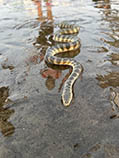Hydrophis schistosus Daudin, 1803
Beaked sea snake
Classification / Names Κοινά ονόματα | Συνώνυμα | CoL | ITIS | WoRMS
Not assigned | Squamata | Elapidae
Environment: milieu / climate zone / εύρος βάθους / distribution range Οικολογία
Υφαλόφιλο(α); εύρος βάθους 3 - 22 m (Αναφ. 78387). Tropical; 31°N - 58°S (Αναφ. 356)
Distribution Χώρες | Περιοχές FAO | Οικοσυστήματα | Παρουσίες | Εισαγωγές
Indo-West Pacific.
Length at first maturity / Μέγεθος / Weight / Age
Γεννητική Ωρίμανση: Lm 74.5, range 47 - 101.5 cm Max length : 140 cm TL αρσενικό/απροσδιόριστο; (Αναφ. 801); common length : 110 cm TL αρσενικό/απροσδιόριστο; (Αναφ. 801)
Short description Μορφολογία
Life cycle and mating behavior Γεννητική Ωρίμανση | Αναπαραγωγή | Γεννοβολία | Eggs | Γονιμότητα | Larvae
Main reference
Αναφορές | Συντονιστής | Συνεργάτες
Redfield, J.A., J.C. Holmes and R.D. Holmes 1978 Sea snakes of the Eastern Gulf of Carpentaria. Aust. J. Mar. Freshwat. Res. 29(3):325-334. (Αναφ. 78387)
IUCN Red List Status
(Αναφ. 130435: Version 2025-1)
CITES status (Αναφ. 108899)
CMS (Αναφ. 116361)
Threat to humans
Human uses
αλιεία: χωρίς ενδιαφέρον
| FishSource |
Εργαλεία
Περισσότερες πληροφορίες
Διαδικτυακές πηγές
BHL | BOLD Systems | CISTI | DiscoverLife | FAO(Publication : search) | Fishipedia | GenBank (genome, nucleotide) | GloBI | Gomexsi | Google Books | Google Scholar | Google | PubMed | Δέντρο Ζωής | Wikipedia (Go, αναζήτηση) | Zoological Record



